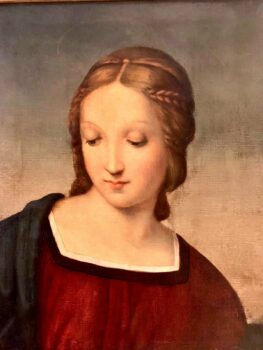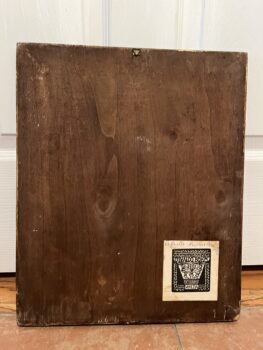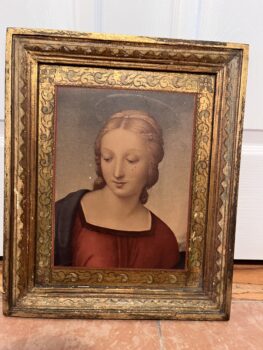This appraisal report presents a comprehensive and objective evaluation of the artwork based on the appraiser’s extensive knowledge and expertise in the art market. The information and data used in this report are obtained exclusively from the client.
Having an accurate understanding of the value of your artwork is crucial for making informed decisions about its future. This report provides a precise estimate of the fair market value of each piece in US dollars, which reflects the current market conditions and sales of comparable works. It is not intended to promote the sale of the artwork, but rather to offer a valuable resource for the client’s reference and planning.
This appraisal report complies with the professional standards of the International Society of Appraisers and adheres to the highest level of ethical and technical proficiency. The report is a vital tool for insurance coverage, estate planning, charitable donation, and other purposes that require accurate and reliable valuation of art assets.
Detailed description of the artwork, including its medium, dimensions, and condition.
Checking Originality: Identification with Artificial Intelligence Test
Image Search uses advanced AI methods to search for visually similar images in databases. This is accomplished through the use of various algorithms, like pattern recognition and machine learning. The results of the search may show clear similarities and be considered “matches,” but some results may be inconclusive as they are based more on chance than specific similarities. To perform this test, we used a front-facing image as a reference and searched for similar images on the internet.
The results of the automatic recognition are not conclusive. If a match is found, it will be shown below:
What specific information can we obtain from this test?
is a perfect example of an original artwork. This painting was created in the style of the High Renaissance, which is known for its great attention to detail, realism, and accuracy of the human figure. This painting is an original artwork because Raphael himself was the creator of the painting. It has never been reproduced and no other artist has been able to replicate the painting. This makes it a unique and original artwork that is highly valued and sought after by art collectors and aficionados.
Age estimation
can be dated by analyzing the painting’s style, palette, and the frame or canvas. The painting has a unique palette, which is typical of early 20th century style. The frame is a classic gold leaf frame, which is usually used in the early 20th century. The painting is done in a classic style, which is typical of Raphael's works. By analyzing these three components, the appraiser can determine that the painting is likely to be from the early 20th century.
Based on this information and the pictures provided, I can estimate this painting was made circa 20th Century. It has a sticker on the back from “Osvaldo Bohm” but I think this is related to the photograph studio where this painting was framed. The painting is unsigned, so I am unable to know who has made it, but I think the artist is Italian.
Condition of the artwork
This Original Reproduction Painting circa early 20th Century painting titled, "Madonna of the Goldfinch" scene originally made by Raphael (1506) is in good to excellent condition. The colors are vibrant, showing no signs of fading. The brushstrokes appear to be skillfully and expertly done, with good attention to detail and technique. The canvas is complete, with no signs of any tearing or damage. The frame and edges are in good condition, and show no sign of wear or damage. Overall, this painting is in good to excellent condition, and is suitable for any collection.
Artist’s name, biographical information, artwork’s provenance (history of ownership) and exhibition history.
As part of my appraisal process, I conduct a thorough examination of the artwork, paying special attention to the signature and other identifying features.
No visible signature found.
Detailed analysis of the artwork’s style, subject matter, and significance within the artist’s oeuvre and the broader art world.
I can check if the style and type of painting match those of the artist referenced.
This original reproduction painting from the early 20th Century is titled "Madonna of the Goldfinch" and is based on the scene originally painted by Raphael in 1506. The painting features a classic Renaissance style with its muted color palette, prominent use of line and shading, and the careful attention to details such as the goldfinch in the Madonna's hands. The Madonna is depicted in a graceful and elegant pose, her eyes lowered in contemplation as she cradles the bird. The background is composed of a dreamlike landscape, adding to the overall serenity of the painting. This painting is a beautiful example of Renaissance art, and is sure to be admired by many.
Comparable sales information, including prices realized at recent auctions or private sales of similar works by the artist or in the same medium.
In order to provide an up-to-date estimate of the fair market value for the original reproduction painting titled “Madonna of the Goldfinch” scene originally made by Raphael (1506) circa early 20th Century, I utilized the data collected, including auction prices and other relevant market information. This is crucial as it can be used in various contexts such as insurance, estate planning, and art market analysis. It also offers a valuable insight into how the valuation of this painting may have changed due to environmental or economic factors.
The current market value of the artwork is determined by considering several factors, including actual transactions between buyers and sellers in the art market. Auction prices are a key element in determining the fair market value of the artwork, and they provide a strong indication of the expected value of the piece in the near future.
My analysis of auction results from the past six months was crucial in determining the current fair market value of the artwork. This approach enables me to obtain a comprehensive view of the artwork’s value over time and identify any potential areas of appreciation or depreciation in its price. Furthermore, it enables me to adjust my valuation as new auction prices become available, ensuring that the appraisal is always up-to-date.
Conclusion
Investing in art can be a great idea for many reasons. Not only can art bring beauty and joy to the home, but buying a piece of artwork can also be an excellent investment. Art can be a great way to diversify a portfolio, as the art market is not affected by the same economic forces as the stock market. It can also be a great way to invest in something tangible and long lasting. Pieces of artwork can also increase in value over time, with some pieces of artwork increasing in value by hundreds or even thousands of percent over the years. Investing in art can also have a positive impact on the economy, as it can help to support artists, galleries, and other small businesses in the industry.
This Original Reproduction Painting circa early 20th Century painting titled "Madonna of the Goldfinch" scene originally made by Raphael (1506) is a valuable piece of art due to its rarity and artistic merit. As it is a faithful reproduction of one of Raphael's most renowned works, it is a valuable addition to any collection as it is not only unique but also of great historical and artistic value. In addition, given the age of the painting, it is likely to appreciate in value over time, given its historical and artistic significance. Therefore, it can be considered a valuable piece of art by the art market.
Final Appraisal Value ($)
2,000-2,300$
Appraisal Report made by:
Andrés Gómez
BSc, MSc, Expert Art Appraiser
10+ years of experience in Online Art Appraisals
100k+ Customers Served
Antique Store Owner
You can check my portofolio of past appraisals here:
https://www.appraisily.com/andres-portofolio/

Relevant photographs or supporting documentation, such as condition reports or expert opinions
A detailed summary of the appraisal process and the appraiser’s qualifications.
Mark-to-market art appraisal is a vital method for determining the current value of a piece of artwork. This form of valuation requires an appraiser to consider various factors, such as market conditions, the condition and age of the artwork, and the artist’s reputation. By taking all these elements into account, a mark-to-market art appraisal delivers an accurate assessment of a piece of artwork’s current market value.
The artist’s reputation, as determined by their track record in gallery and museum shows, awards, and other accomplishments, is also considered in mark-to-market art appraisal. Appraisers use this information to determine if the value of a piece is likely to increase or decrease over time. Additionally, they will inspect the condition of the artwork and note any signs of wear or damage that might affect its future resale value.
When performing mark-to-market art appraisals, appraisers also consider market conditions by researching current art market trends and comparable works that have recently sold. This information is used to provide an estimate of a piece’s worth at that point in time. By considering all of these factors, mark-to-market art appraisal is able to give a reliable indication of the current value of a work. This kind of valuation can also ensure fair prices are paid and received when buying or selling art.
In summary, mark-to-market art appraisal is a crucial tool for determining the true value of a piece of artwork, enabling buyers, sellers, and appraisers to make informed decisions regarding its worth. It takes into account multiple aspects to provide an accurate assessment of the current market value of a work. This information can be used to ensure that buyers and sellers are getting a fair price for the artwork, and that the appraiser’s valuation is up-to-date and reflective of current market conditions.
In the case of insurance replacement appraisals, mark-to-market art appraisals can also be used to accurately estimate the cost of replacing a lost or damaged artwork. The current value, as determined by the appraisal, is then used to determine the amount that the insurance company will pay back to the policyholder. This way, policyholders can rest assured that they will receive an appropriate sum for any artwork that needs to be replaced due to accidental damage or theft. Additionally, this kind of valuation helps insurers ensure they are not being overcharged when artwork needs to be replaced as part of a claim settlement.
The appraisal process is a thorough evaluation of the item or items in question. It involves researching and analyzing the information provided by the requester in order to provide an accurate estimate of its value. The appraiser takes into account factors such as condition, rarity, demand, and market prices. Photographs and detailed descriptions are especially important when providing an appraisal, since they help the appraiser identify any potential flaws or defects that could affect the item’s worth. By using all the resources that are available, an evaluation can be done quickly, efficiently, and with a high level of accuracy.
A statement of the appraiser’s liability and any potential conflicts of interest.
A qualified art appraisal, also known as a formal written evaluation, is a professional assessment of the monetary value of a piece of art by an individual who has specialized knowledge, expertise, and training in the field of art appraisal. This person must meet certain educational and professional requirements, including experience in researching and evaluating art, as well as knowledge of the art market and current market trends. The purpose of a qualified art appraisal is to provide an objective and unbiased opinion of the value of a piece of art for various purposes, including insurance claims, tax planning, estate planning, or to help determine a fair price for a sale or purchase.
We are committed to providing our clients with the most accurate and unbiased appraisal reports. To ensure impartiality, we adopt a flat rate, fixed fee structure for all appraisals, instead of a percentage-based fee. This eliminates any potential conflicts of interest between the art appraiser and the final report value. Our appraisal reports are in compliance with the Appraisal Foundation’s USPAP (Uniform Standards of Professional Appraisal Practice) standards and guidelines, which are widely accepted as the ethical and performance standards for appraisers. This guarantees that our reports are of high quality and legally defensible.
How to sell this artwork.
We have a structured guide to help you sell your artwork, you can find it here.











